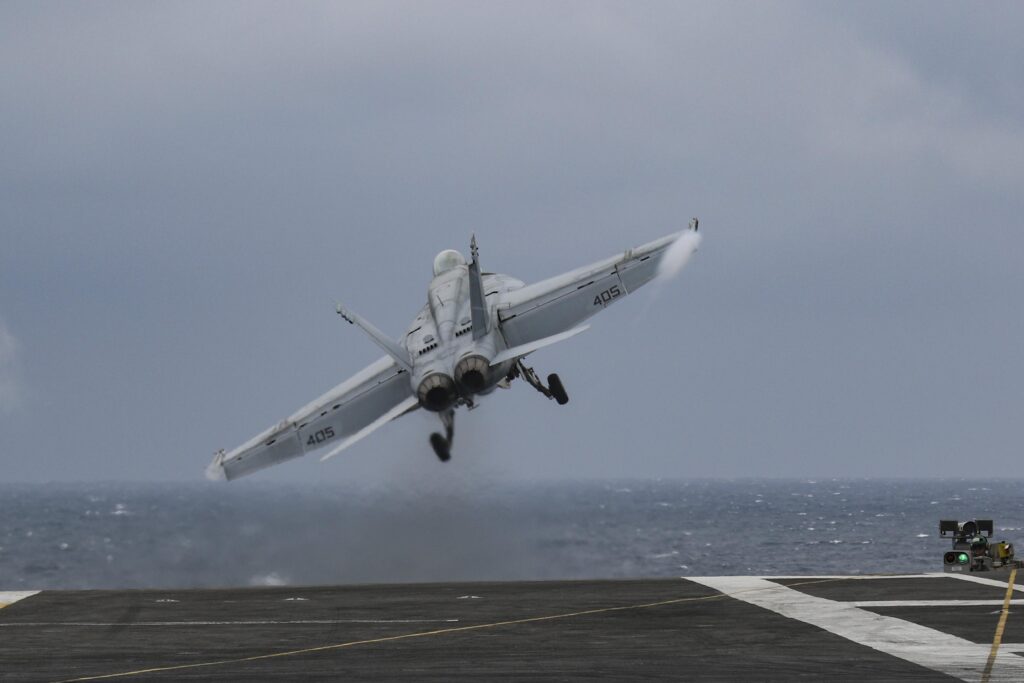
ARLINGTON, Va. — The Navy is planning to use a “rheostat” approach to adjust the F/A-18E/F Super Hornet strike fighter Service Life Modernization (SLM) program to mitigate the strike fighter shortfall in the fleet, a senior service official said.
The SLM is a sustainment program designed to increase the service life of Block II F/A-18E/Fs. The initial SLM phase extended the service life from 6,000 flight hours to 7,000 flight hours. The program beginning in 2023 will increase the service life to 10,000 flight hours. The line also will be used to upgrade many Block II aircraft to the Block III configuration.
During an April 27 hearing of the House Armed Services Committee’s subcommittee on Tactical Air and Land Forces, the chairman, Rep. Donald Norcross (D-New Jersey), said in his opening remarks that “two years ago the strike fighter shortfall would have lasted until 2030. However, last year the Navy told us that the strike fighter shortfall would be resolved to zero in 2025, primarily due to the solid justification for terminating the new F/A-18 Super Hornet line.”
Norcross said he was skeptical of this year’s analysis of the F-35C production rate and the “lackluster” F/A-18E/F SLM program and the “non-rapid development of the Navy’s Next-Generation Air Dominance [program].”
He said the Congress authorized the procurement of 12 F/A-18/E Super Hornets in the 2022 budget as “risk mitigation,” aircraft the Navy said that it did not want. The Navy also did not request any Super Hornets in the 2023 budget proposal.
He said the Navy’s strike fighter shortfall “will not be resolved until six years later [from 2025] in 2031 because of further unplanned reduction in F-35 purchases, reduced aircraft inductions into the F/A-18 [SLM] program.”
Frederick “Jay” Stefany, performing the duties of assistant secretary of the Navy for Research, Development and Acquisition, told the subcommittee that said the SLM program had been “stabilized.”
Rear Adm. Andrew Loiselle, director, Air Warfare Division in the Office of the Chief of Naval Operations, said the Navy has drilled down on the issues with the SLM and has begun to turn around the cost of the program.
“In the past year we’ve seen a 30% percent cost reduction in our Phase One 7,500-hour SLM deliveries due to the implementation of best practices with pre-SLM grooming, engineering reutilization and overall touch-flavor learning and efficiencies,” he said.
“We expect continued cost savings as SLM matures and we are executing our planned transition to full-kit, 10,000-hour SLM inductions if fiscal ’23,” Loiselle said. “Full-kit inductions will provide full Block III capability identical to new production aircraft at one third of the cost, giving us 4,000 additional flying hours, or enough to fly for 13 additional years.
“Right now, our SLM plan is our rheostat that we’re using to control availability in the out years, depending on schedules and future budgets that are unknown at this point in time,” he said. “Right now, I do not plan to do SLM on the entirety of my Block II force and I do not plan to do it on my Block I force. If there are changes in the future that require additional capabilities [and] I need more Block III aircraft, then I have the ability to dial up that rheostat on SLM and be able to do that for a longer period of time and to potentially use the FRCs [Fleet Readiness Centers] to increase capacity for SLM beyond the currently planned 35 per year.”
Loiselle said two Block I Super Hornets were put through SLM but based on the results the Navy decided not to proceed with SLM of Block I aircraft “unless there is some requirement to do so in the future.”
Loiselle said the turn-around time of an SLM will be 15 months.
Boeing currently is building Block III Super Hornets to the Navy. At the current production rate, the production is expected to run to the first quarter of fiscal 2026, Loiselle said.
- SECNAV Advocates Increased Legal Immigration to Increase Shipbuilder Workforce - April 23, 2024
- Insitu Going Strong at 30, Focusing on Maritime Operations - April 8, 2024
- Navy Awards Boeing Additional Funds for MQ-25 Drones for Testing - April 3, 2024






